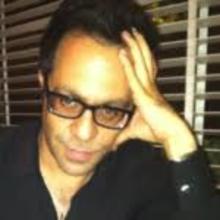Farbod Honarpisheh
Biography
I am currently a postdoctoral associate with Yale’s Film and Media Studies Program. My dissertation, “Fragmented Allegories of National Authenticity: Art and Politics of the Iranian New Wave Cinema of the 1960s and 1970s,” was completed at Columbia University. My research interests intersect film and media theory and history, critical theory, Iranian and Middle Eastern cinemas, comparative modernist studies (visual and literary), intermediality, the modern city, postcolonial theory, migration, and documentary studies.
I left my hometown of Shiraz in Iran soon after finishing high school. Crossing over, I first lived in Istanbul and then Vienna for a number of years, finally landing in Montreal. I obtained BA and MA degrees in film studies from Concordia University. After moving to New York and Columbia University, I completed a second MA. Entitled “In the Labyrinth of Yeşilçam: Transient Cosmopolitanism, Passing Images of a Street, and a Theater in Istanbul,” my thesis essay marked a new turn in my work towards the nexus of materiality/temporality. Yeşilçam, a street located in Istanbul’s historically most heterogeneous district (in language, faith, nationality, sexuality) of Pera/Beyoğlu, is above all linked with the emergence of the Turkish film industry in the decades following WWII. My essay is formed by the juxtaposition of two tracks, differentiated by their tone of address and the kind of past they evoke. So while one consists of personal recollections, my memories of when I first started to frequent the street and its movie theaters after leaving Iran, the other is explicitly concerned with a collective past. The second track, forming the main body of the essay, undertakes a detailed examination of the construction of Yesilçam in the public imagination. The personal and collective registers of my writing come together as I establish a “pre-history” for myself, as an immigrant, in Yeşilçam.
My doctoral dissertation focused on the Iranian New Wave cinema, as the large body of “quality films” made before the 1979 revolution came to be known. However, from start to end, this primary track of investigation is opened up to other mediums of cultural production, most important among them: modernist Persian fiction and poetry, the contemporary visual arts scene, and ethnographic writings. The Iranian New Wave, I argue, always showed an ethnographic register. Through a number of writerly (Barthes) textual analyses I illustrate how the profilmic bodies of the subjects filmed, just as it has often been in the case of ethnographic films made in other parts of the world, leave their mark on the aesthetic qualities of these cinematic texts. This emergence of the materiality of the body—in its movements, rhythms, sounds, affecting and re-fashioning, the formal qualities of the film—is established as a local manifestation of a recurrent dynamic in the history of both modernist and ethnographic modes of filmmaking.
Cutting right across the study, the perceived temporal divide between the urban and the rural finds its reflection even in the way that some of its chapters are organized. Hence, the allegory of the city, and that of the country. But, where ends the national allegory, a matter still conditional on imagined continuity, other forms of allegory come to the surface. Critical reading in this sense becomes an act of reproduction, further opening up fissures and discontinuities of what is already deemed as petrified, whether of the national or of realism. Retaining a faith in the cinema’s ability to redeem physical reality, certain manifestations of materiality come to the fore through my close readings of films from the New Wave: the museum display, the archaeological site, the ruin, the body, the mud brick wall, the moving car, and the old neighborhood passageway.
My more recent work shows both continuity and new departures. My current project, still with the working title, “From ‘Dead’ Objects to Moving Vitrines; the Excavation Site, the Museum, and Emergence of the New,” is in part a response to the scholarship on the “arrival” of film in the museum. More specifically, it examines the larger question of modernism through the three themes of “archaeology,” the “excavation site,” and the “museum.” I approach these themes as physical sites, and as recurrent discursive tropes both in cinema/art practice and in political and philosophical thought. As material mediums with formal and temporal qualities of their own, their return in modern cinema and art, whether in the Iranian New Wave films or in other cultural landscapes, was hardly a coincidence. A tale of traveling materialities as much as one of modernisms.
Website: https://columbia.academia.edu/FarbodHonarpisheh
Education
Ph.D. Comparative Lit. (Disciplinary Track in Cinema Studies) and Middle Eastern Studies, Columbia University
M.A. Comparative Lit. (Disciplinary Track in Cinema Studies) and Middle Eastern Studies, Columbia University
M.A. Cinema Studies, Concordia University
B. A. Cinema Studies, Concordia University
D.E.C. (Diplôme d’études collégiales), Communication Studies and Liberal Arts, Vanier College
